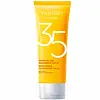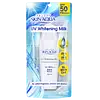What's inside
What's inside
 Key Ingredients
Key Ingredients

 Benefits
Benefits

 Concerns
Concerns

 Ingredients Side-by-side
Ingredients Side-by-side

Alcohol
AntimicrobialTocopherol
AntioxidantPantothenic Acid
Skin ConditioningWater
Skin ConditioningEthylhexyl Methoxycinnamate
UV AbsorberButyloctyl Salicylate
Skin ConditioningButyl Methoxydibenzoylmethane
UV AbsorberOctocrylene
UV AbsorberPropylene Glycol
HumectantHydroxyethyl Acrylate/Sodium Acryloyldimethyl Taurate Copolymer
Emulsion StabilisingTocopheryl Acetate
AntioxidantPhenoxyethanol
PreservativeSodium Acrylates Copolymer
Chlorphenesin
AntimicrobialPropanediol
SolventLecithin
EmollientAllantoin
Skin ConditioningPanthenol
Skin ConditioningDisodium EDTA
Parfum
MaskingEthylhexylglycerin
Skin ConditioningArtemisia Capillaris Flower Extract
Skin ConditioningAlcohol, Tocopherol, Pantothenic Acid, Water, Ethylhexyl Methoxycinnamate, Butyloctyl Salicylate, Butyl Methoxydibenzoylmethane, Octocrylene, Propylene Glycol, Hydroxyethyl Acrylate/Sodium Acryloyldimethyl Taurate Copolymer, Tocopheryl Acetate, Phenoxyethanol, Sodium Acrylates Copolymer, Chlorphenesin, Propanediol, Lecithin, Allantoin, Panthenol, Disodium EDTA, Parfum, Ethylhexylglycerin, Artemisia Capillaris Flower Extract
Water
Skin ConditioningEthylhexyl Methoxycinnamate
UV AbsorberButylene Glycol
HumectantMethylene Bis-Benzotriazolyl Tetramethylbutylphenol
UV FilterPolymethylsilsesquioxane
Cyclopentasiloxane
EmollientTranexamic Acid
AstringentDiethylamino Hydroxybenzoyl Hexyl Benzoate
UV FilterPolysorbate 60
EmulsifyingCetearyl Alcohol
EmollientSilica
AbrasiveBis-Ethylhexyloxyphenol Methoxyphenyl Triazine
Skin ConditioningDecyl Glucoside
CleansingTitanium Dioxide
Cosmetic ColorantPhenoxyethanol
PreservativeTriethanolamine
BufferingAcrylates/C10-30 Alkyl Acrylate Crosspolymer
Emulsion StabilisingHexylglycerin
HumectantDisodium EDTA
Propylene Glycol
HumectantXanthan Gum
EmulsifyingSodium Acetylated Hyaluronate
HumectantWater, Ethylhexyl Methoxycinnamate, Butylene Glycol, Methylene Bis-Benzotriazolyl Tetramethylbutylphenol, Polymethylsilsesquioxane, Cyclopentasiloxane, Tranexamic Acid, Diethylamino Hydroxybenzoyl Hexyl Benzoate, Polysorbate 60, Cetearyl Alcohol, Silica, Bis-Ethylhexyloxyphenol Methoxyphenyl Triazine, Decyl Glucoside, Titanium Dioxide, Phenoxyethanol, Triethanolamine, Acrylates/C10-30 Alkyl Acrylate Crosspolymer, Hexylglycerin, Disodium EDTA, Propylene Glycol, Xanthan Gum, Sodium Acetylated Hyaluronate
 Reviews
Reviews

Ingredients Explained
These ingredients are found in both products.
Ingredients higher up in an ingredient list are typically present in a larger amount.
Disodium EDTA plays a role in making products more stable by aiding other preservatives.
It is a chelating agent, meaning it neutralizes metal ions that may be found in a product.
Disodium EDTA is a salt of edetic acid and is found to be safe in cosmetic ingredients.
Learn more about Disodium EDTAEthylhexyl Methoxycinnamate is an organic compound that provides UVB protection. It often goes by the more common name of octinoxate. It is created from methoxycinnamic acid and 2-ethylhexanol.
Ethylhexyl Methoxycinnamate absorbs UVB rays with wavelengths between 280-320 nm. UV absorbers protect your skin by using chemical reactions to convert UV rays into heat and energy.
UVB (290-320 nm) rays emit more energy than UVA rays. They are capable of damaging DNA, causing sunburns and are thought to be linked to skin cancer.
The state of Hawaii has banned sunscreens containing octinoxate due to its potential impact on coral reefs. More research is needed to bridge gaps in this research. The European Union allows higher levels of octinoxate in sunscreens than the US and Australia.
Ethylhexyl Methoxycinnamate is oil soluble. It is not stable and may lose efficacy when exposed to sunlight.
Learn more about Ethylhexyl MethoxycinnamatePhenoxyethanol is a preservative that has germicide, antimicrobial, and aromatic properties. Studies show that phenoxyethanol can prevent microbial growth. By itself, it has a scent that is similar to that of a rose.
It's often used in formulations along with Caprylyl Glycol to preserve the shelf life of products.
Propylene Glycol is an odorless, colorless liquid. As a humectant, it helps skin retain moisture. It also aids in delivering active ingredients.
Another role of this ingredient is preventing a product from melting or freezing. Propylene glycol also adds antimicrobrial properties to a product, elongating product lifespan.
This ingredient is considered an organic alcohol and commonly added into both cosmetics and foods.
Those with sensitive skin or conditions may develop a rash when using this ingredient.
Learn more about Propylene GlycolWater. It's the most common cosmetic ingredient of all. You'll usually see it at the top of ingredient lists, meaning that it makes up the largest part of the product.
So why is it so popular? Water most often acts as a solvent - this means that it helps dissolve other ingredients into the formulation.
You'll also recognize water as that liquid we all need to stay alive. If you see this, drink a glass of water. Stay hydrated!
Learn more about Water